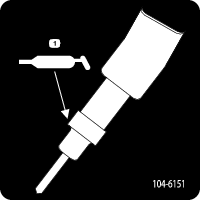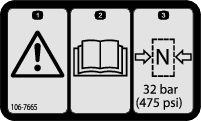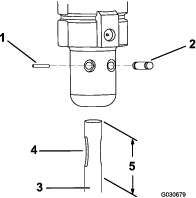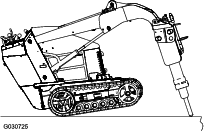Maintenance
Caution
If you leave the key in the ignition switch, someone could accidently start the engine and seriously injure you or other bystanders.
Remove the key from the ignition before you do any maintenance.
Recommended Maintenance Schedule(s)
| Maintenance Service Interval | Maintenance Procedure |
|---|---|
| Before each use or daily |
|
| Every 40 hours |
|
| Every 500 hours |
|
Greasing the Bit
| Maintenance Service Interval | Maintenance Procedure |
|---|---|
| Before each use or daily |
|
| Every 40 hours |
|
Grease type: No. 1 or No. 2 general-purpose grease
-
Tilt the breaker so that it is vertical and lower it to the ground to push the bit up into the breaker until it stops.
Important: If you do not push the bit up into the breaker before greasing, grease may fill the space between the top of the bit and the breaker piston. This causes the piston to pressurize the grease and damage the seal when you next use the breaker.
-
Stop the engine and remove the key.
-
Clean the grease fitting with a rag.
-
Connect a grease gun to the fitting (Figure 6).

-
Pump grease into the fitting until either grease begins to ooze out of the lower bushing and retaining pin or pumping the grease gun becomes difficult.
-
Wipe up any excess grease.
Charging the Nitrogen
| Maintenance Service Interval | Maintenance Procedure |
|---|---|
| Every 500 hours |
|
Inside the breaker is an accumulator, a chamber of pressurized nitrogen. After several hours of use the pressure may decrease, reducing the performance of the breaker.
Strong vibrations in the auxiliary hydraulic hoses are a sign the pressure is dropping in the chamber. If this should happen, bring the breaker to your Authorized Toro Dealer to be charged.
Warning
Within the breaker is a chamber containing pressurized nitrogen, which under the right circumstances could explode, injuring or killing you or bystanders.
-
Do not take apart the body of the breaker.
-
Do not attempt to charge the chamber yourself. Always take the breaker to an Authorized Toro Dealer for charging.
-
Ensure that the breaker is charged only with nitrogen. Other gases can explode.
-
Do not ship the charged breaker via air freight.










